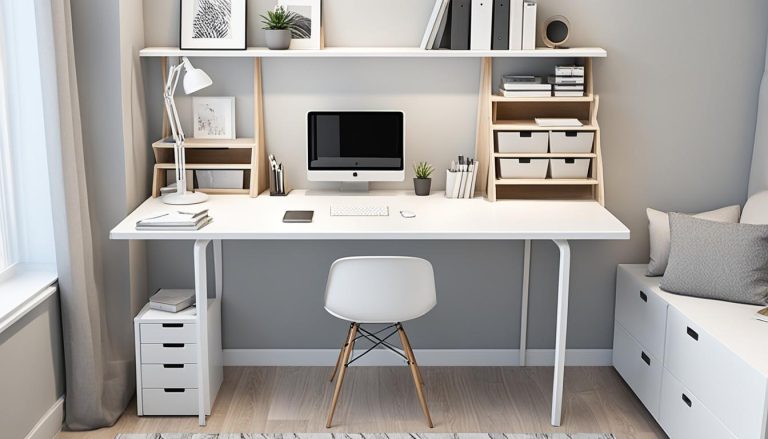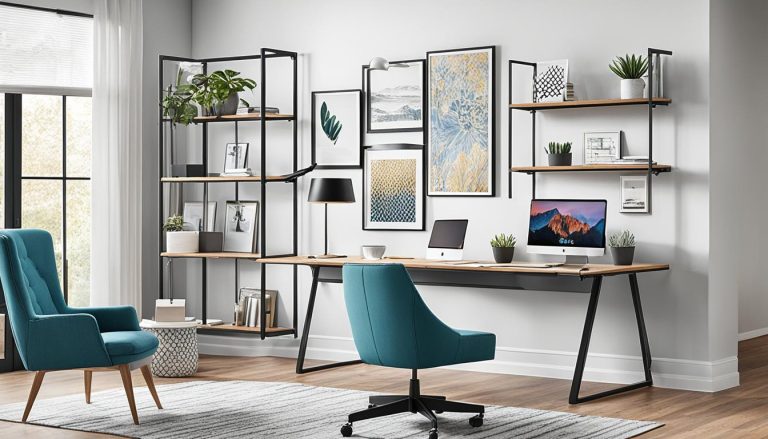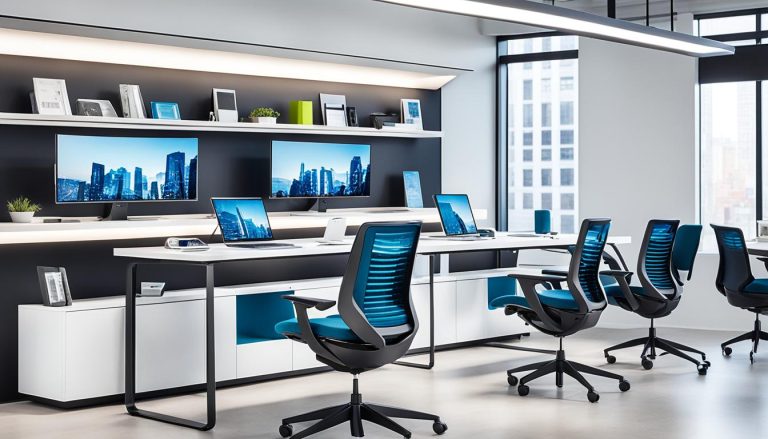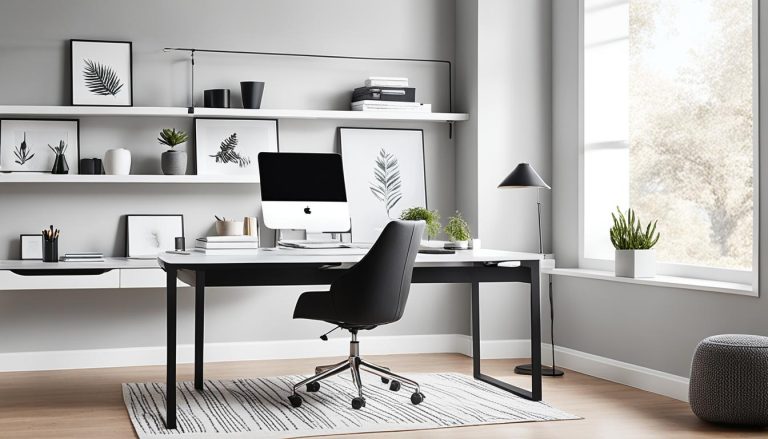Ergonomic Home Office Furniture Essentials Guide: Boost Comfort and Productivity
houseremodelingnews.com may earn a commission if you purchase a product through one of our links
Imagine sitting at your home office, hunched over a laptop on your dining table. Your back hurts, your wrists are sore, and you have a headache. Many of us can relate to this feeling. With more people working from home, the need for ergonomic furniture has become clear.
Sarah, a graphic designer from New York, used to have neck pain and eye strain. But after getting an adjustable chair, standing desk, and monitor arm, everything changed. “It’s like night and day,” she says. “I work longer without pain, and my creativity has grown!”
Sarah’s story is common. Studies show ergonomic setups can cut musculoskeletal disorders by up to 60% and increase productivity by 20%. Whether you work remotely or run a small business, an ergonomic office is key for your health and success.
This guide will cover ergonomic office chairs, standing desks, and monitor arms. We’ll show you how to make your workspace both comfy and efficient. Say goodbye to aches and hello to better work. Let’s get started!
Introduction to Ergonomic Home Office Furniture
Setting up an ergonomic home office is key for your health and work efficiency. With more people working from home, knowing how ergonomics helps your workspace is vital.
The importance of ergonomics in home workspaces
An ergonomic workstation cuts down on discomfort and health problems. Research shows 88% of office workers suffer from eye strain, back pain, and discomfort from sitting too long without the right support. Ergonomic solutions can stop these issues and make you feel better overall.
Benefits of investing in ergonomic furniture
Ergonomic furniture has many advantages:
- Less risk of musculoskeletal disorders
- Better posture and spinal alignment
- More comfort and productivity
- Less eye strain and fatigue
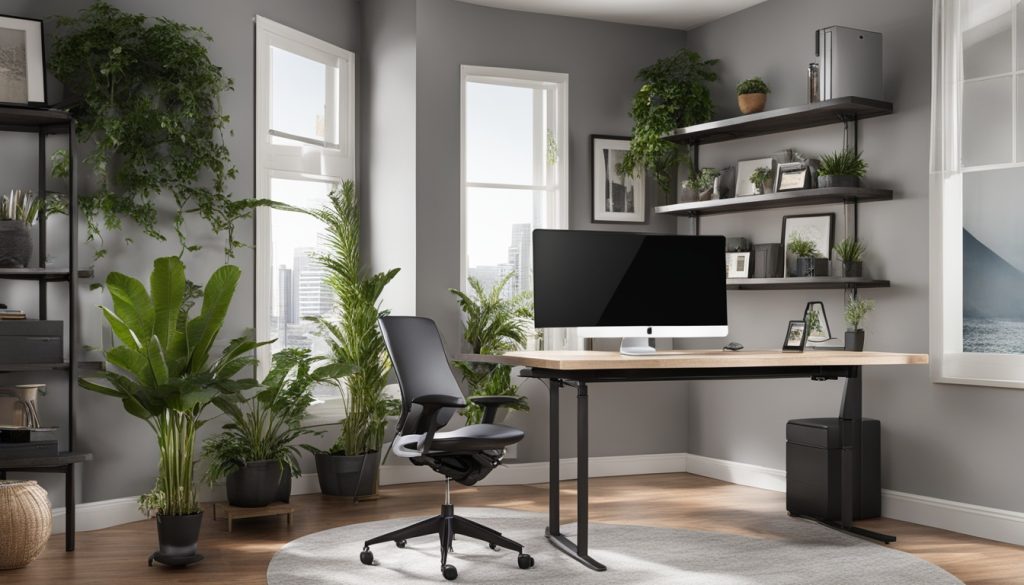
Overview of essential ergonomic home office items
For a great ergonomic workstation, think about these important pieces:
- Ergonomic chair with lumbar support
- Adjustable standing desk
- Ergonomic keyboard and mouse
- Monitor arm for correct screen placement
- Task lighting to lessen eye strain
Adding these items will bring you the best of ergonomic furniture and make your home office both comfy and productive.
Good ergonomics can change how you work, cutting down on physical strain and increasing your efficiency.
Ergonomic Office Chairs: The Foundation of Comfort
Ergonomic office chairs are key to a comfy and productive workspace. With more people working from home, getting a good chair is more important than before. Let’s look at the main features, top picks, and how to adjust ergonomic chairs right.
Key Features to Look for in an Ergonomic Chair
When looking for ergonomic office chairs, keep an eye on these important features:
- Adjustable seat height
- Lumbar support
- Adjustable armrests
- Tilt and recline options
- Breathable materials
Research shows that chairs with good lumbar support can cut back pain by 90%. Adjustable armrests make people 15% happier than those with fixed ones.
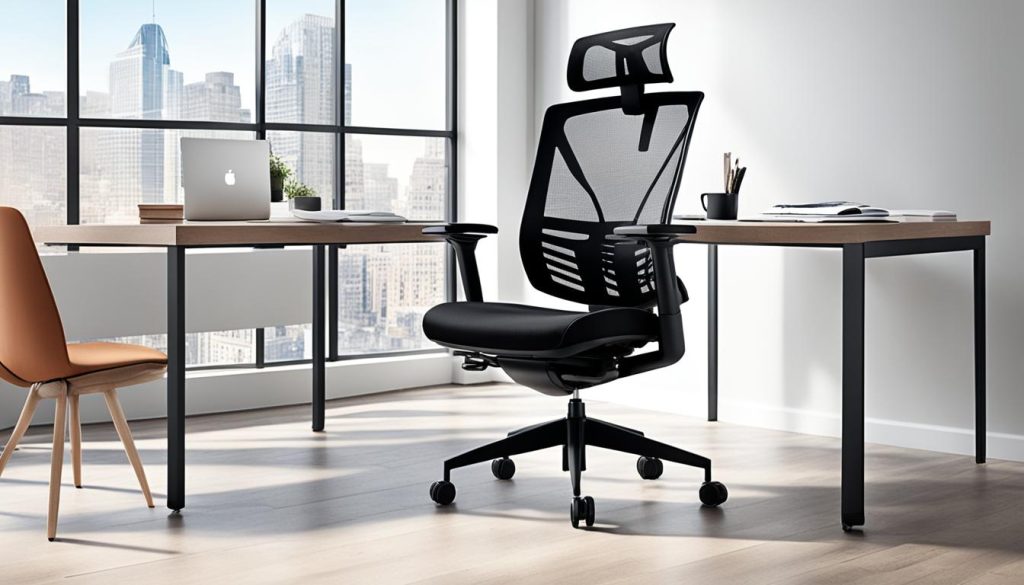
Top Ergonomic Chair Recommendations
Here are some top-rated ergonomic office chairs:
- RFM Preferred Seating Verte: Molds to your spine’s shape
- RFM Carmel Big & Tall: Supports up to 400 pounds
- RFM Sierra: Offers air lumbar and leather headrest options
- RFM Ray Series: Personalized fit for different body types
The global market for ergonomic furniture is expected to grow by 5% each year until 2026. This shows more people want these products.
Proper Chair Adjustment Techniques
To get the most comfort and support, follow these tips:
- Set the seat height so your feet rest flat on the floor
- Adjust lumbar support to keep your spine in its natural curve
- Position armrests to support your elbows at a 90-degree angle
- Tilt the seat slightly forward to ease pressure on your thighs
Choosing the right ergonomic chair and adjusting it correctly can greatly improve your comfort and work efficiency at home.
Standing Desks and Height-Adjustable Workstations
Standing desks and height-adjustable workstations are changing the game for home offices. They let you switch between sitting and standing during your workday. This helps you stay healthier and more productive.
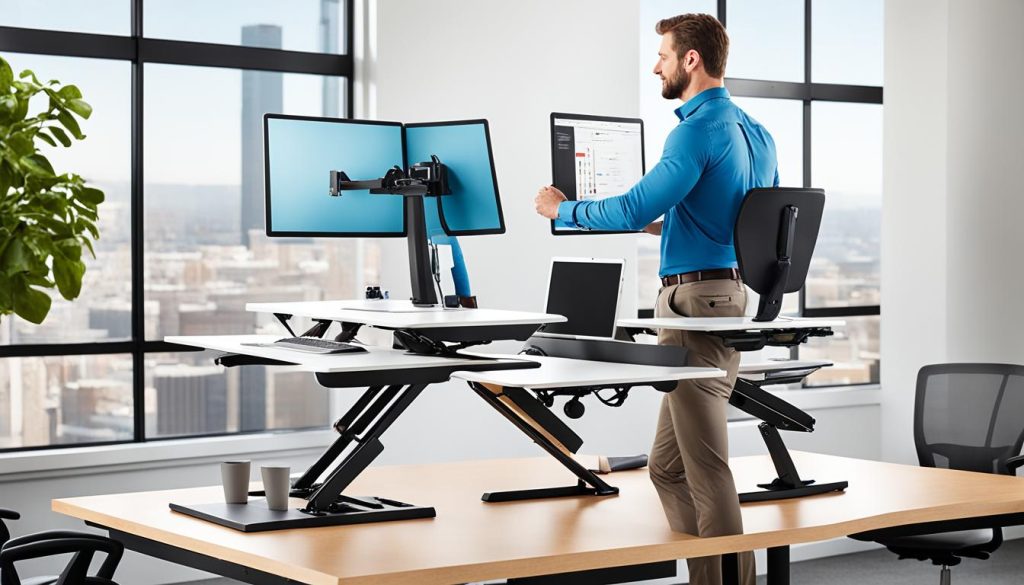
Sit-stand desks are available in many models to fit different needs and budgets. The Float standing desk by Humanscale starts at $2038. It has a special counterbalance for easy height changes. It supports desks from 48″ to 72″ wide and can be adjusted from 26.4″ to 46.2″ tall.
If you’re looking for something more affordable, check out the Rise Up Essential Electric Standing Desk. It costs $249.99 (29% off the regular price). This desk can go from 27.6-48.3 inches tall and supports up to 155 lbs. It fits a wide range of setups, from laptops to multiple monitors.
- Seamless adjustment between sitting and standing
- Improved circulation and reduced back pain
- Increased energy levels throughout the day
When using a standing desk, keep your posture right. Make sure your eyes are level with the screen and your elbows are at 90 degrees. Switch between sitting and standing to get the most out of your desk.
Ergonomic Keyboards: Typing Comfort and Wrist Health
Ergonomic keyboards are key to keeping your wrists healthy and making typing more comfortable. They are designed to lessen strain during long typing sessions.
Split Keyboard Designs
Split keyboards are great for ergonomic setups. They let your hands rest naturally, which reduces wrist strain. The Microsoft Sculpt Ergonomic Keyboard is a favorite for its comfort and good price.
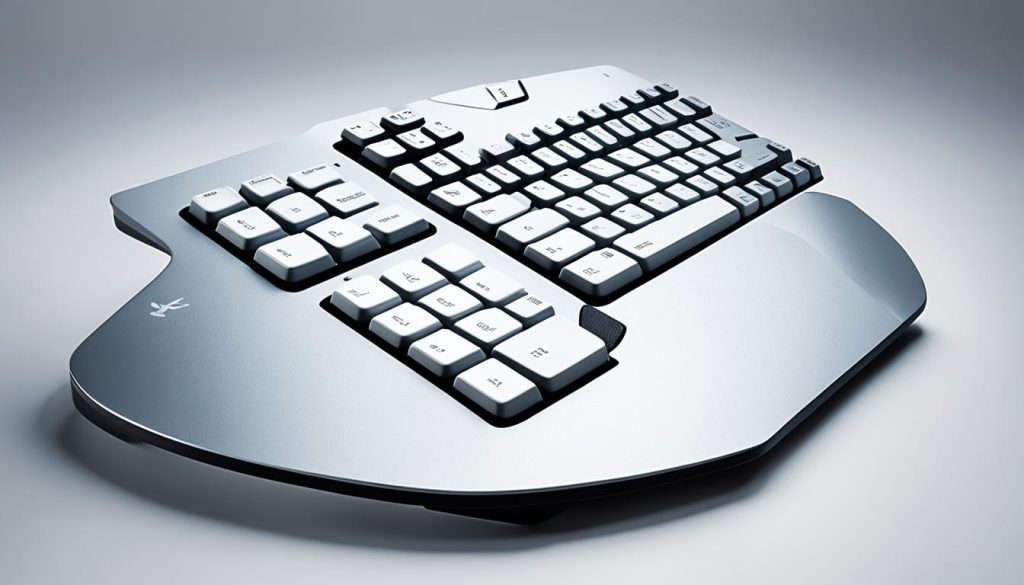
Ergonomic Keyboard Tray Placement
Putting your keyboard tray in the right spot is vital for a neutral wrist position. Angle your tray slightly downward to keep wrists relaxed. This setup helps avoid injuries from typing too much.
Wrist Rest Considerations
Wrist rests can offer extra support, but use them with care. Resting your wrists too much can harm the carpal tunnel. Aim to keep your wrists above the keyboard while typing.
- Choose a keyboard with a flat or negative slope
- Look for models with customizable key placement
- Consider keyboards with built-in tenting features
Finding the best ergonomic keyboard means trying different ones until you find what feels right. Take your time adjusting to new designs. Don’t be afraid to explore various options to discover your ideal match.
Ergonomic Mice and Trackballs: Reducing Hand Strain

Ergonomic mice and trackballs are key to preventing hand strain during long computer use. They have special designs that keep your hands in natural positions. This reduces repetitive motions, making work more comfortable and efficient.
The Logitech Lift Vertical Wireless Mouse is a great example. It keeps your hand in a handshake position, cutting down muscle strain by 20% compared to regular mice. It costs $64.44 and has customizable side buttons. You can use it wirelessly via Bluetooth or a receiver.
Trackballs are another good option for those with wrist pain. They need less movement of the elbow and wrist, perfect for small spaces. The Logitech MX Ergo trackball is a top choice:
- 20% less muscle fatigue in hand, wrist, and forearm
- Adjustable tilt angle (0° or 20°) for better posture
- Up to 4 months of use on a full charge
- Works with Windows, macOS, Chrome OS, and Linux
For those looking for top-notch performance, the Razer Viper V2 Pro is super light and 25% faster than others. The Logitech MX Master 3S, priced at $99.99, gives you up to 70 days of battery life and connects to three Bluetooth devices.
Choosing the right ergonomic mouse or trackball can greatly reduce hand strain. It also boosts your productivity in your home office.
Monitor Arms and Proper Screen Positioning
Setting up your monitor right is key for a comfy and productive workspace. Getting your screen in the right spot can stop neck strain, eye fatigue, and make work better.
Ideal Monitor Height and Distance
The top of your screen should be at eye level. This keeps your neck right and cuts down on strain. Keep your monitor 18 to 28 inches away from your face. This lets you see the whole screen without eye or neck trouble.
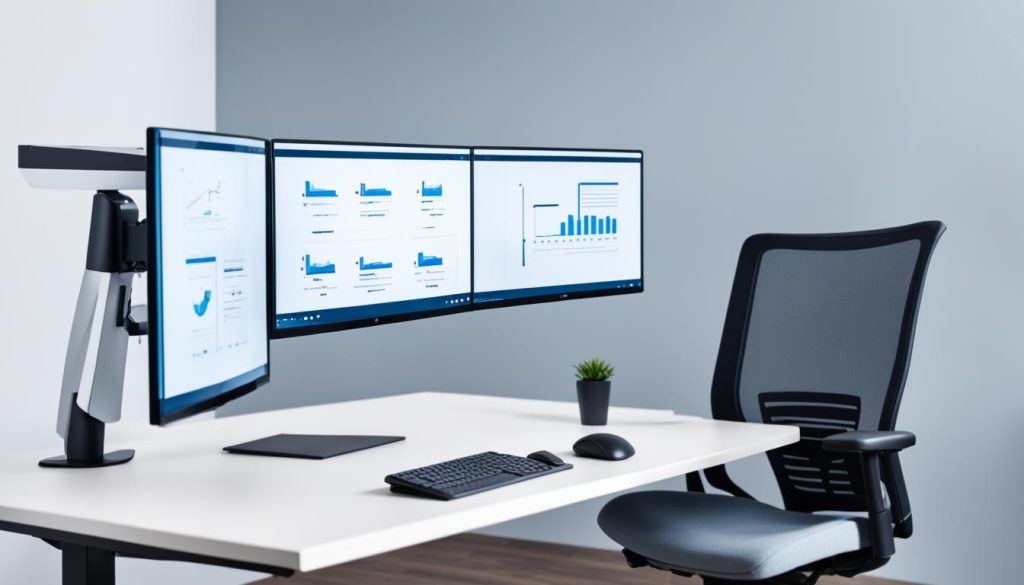
Benefits of Adjustable Monitor Arms
Monitor arms let you change your screen’s height, angle, and distance. They’re great if you share your space or switch between sitting and standing. This flexibility makes work easier.
Dual Monitor Setup Considerations
For two monitors, put your main screen right in front of you. The second screen should be a bit off to the side. This setup cuts down on neck movement and keeps viewing comfy. Make sure both screens are at the same height and distance from your eyes.
Remember, getting your monitor set up right is crucial for avoiding discomfort and staying productive. Take the time to adjust your setup and listen to what your body tells you. Your eyes and neck will be grateful!
Ergonomic Home Office Furniture Essentials
Creating a comfy and efficient home office begins with the right furniture. An ergonomic desk, chair, and monitor stand are key. They help you stay in good posture and reduce strain. Let’s look at these elements and how they help your productivity and health.
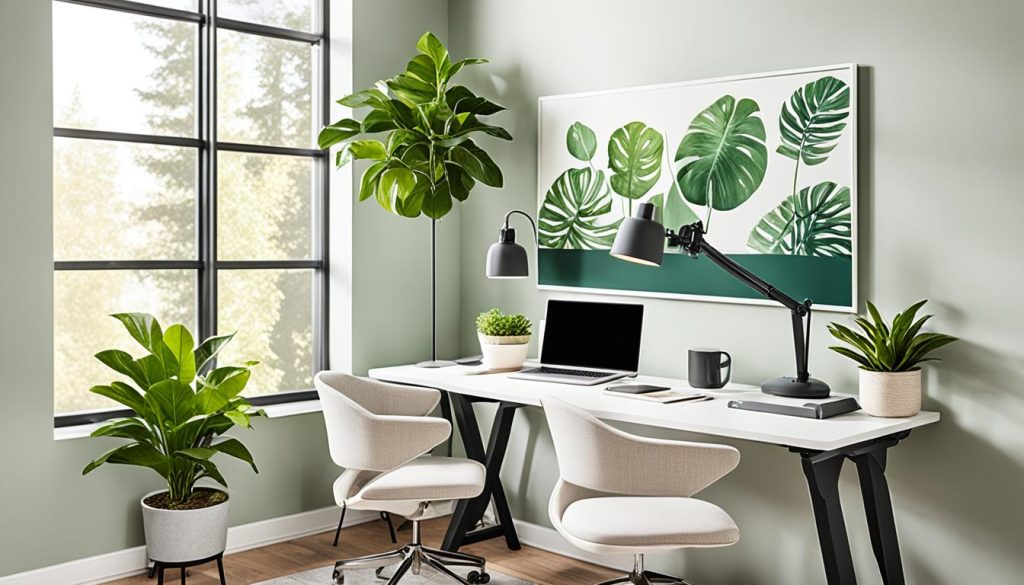
The ergonomic desk is your main work area. Pick one that adjusts in height, letting you switch between sitting and standing all day. This can cut musculoskeletal issues by 68% compared to regular desks.
An ergonomic chair is vital for keeping your posture right during long hours. Look for one with adjustable lumbar support, armrests, and seat height. A good ergonomic chair can increase productivity by 86%.
A monitor stand is also important. Putting your screen at eye level cuts neck strain by up to 40%. This simple step can greatly improve your comfort during the workday.
- Adjust your chair height so your feet rest flat on the floor
- Position your monitor arm’s length away
- Keep your keyboard and mouse at elbow height
These essentials might seem expensive at first, but think of them as an investment in your health and work. Start with the basics and add more ergonomic items over time.
“A well-designed workspace isn’t just about comfort—it’s about creating an environment that supports your best work.”
Everyone is different. Take time to find the right ergonomic solutions for your work style and body needs. Your body will be grateful later.
Footrests and Anti-Fatigue Mats: Supporting Lower Body Comfort
Your lower body needs support during long work hours. Footrests and anti-fatigue mats are key for comfort whether you’re sitting or standing. These tools help reduce fatigue and boost circulation in your legs and feet.
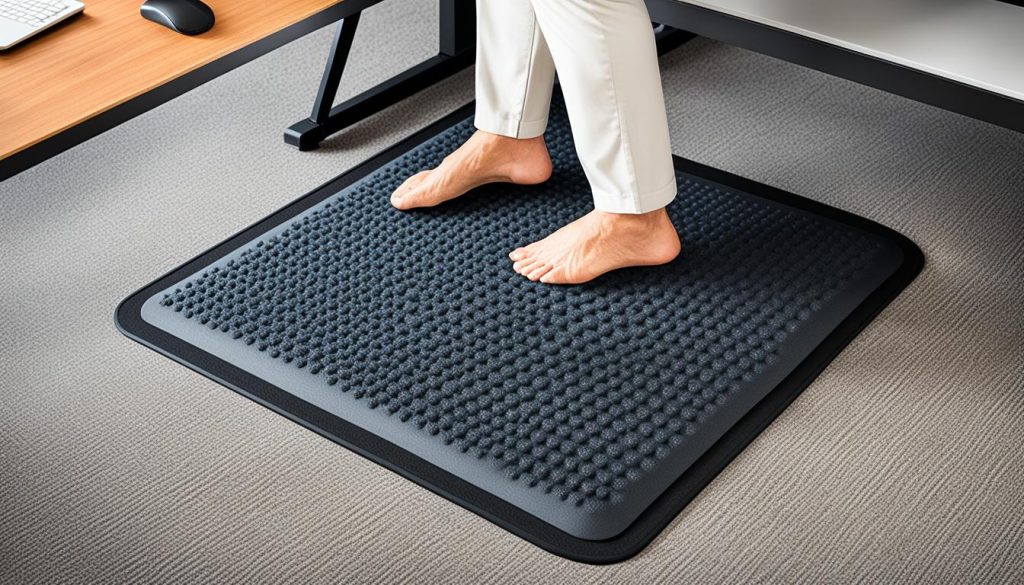
Footrests are great for seated work. They let you adjust your leg position, easing pressure on your lower back. Some footrests, like the Humanscale FR300, even allow movement. This helps keep your legs active while you sit.
For standing desk users, anti-fatigue mats are a must-have. They cushion your feet and legs, reducing strain from hard floors. The Ergodriven Topo mat is a top pick. It’s been tested for years and comes with a seven-year warranty. You can choose from colors like gray, blue, and purple.
- Topo mat is available in multiple sizes
- Smaller version for users under 5’4″
- Weighs 8 lbs and measures 20″ H x 29″ W x 0.8″ D
Another option is the Monarch Mat by Humanscale. It’s pricier at $230 but offers excellent support. Whichever you choose, these tools will help keep your lower body comfy all day long.
“Investing in lower body support is crucial for maintaining comfort and productivity in your home office setup.”
Proper Lighting Solutions for Eye Health
Good lighting is key for your eye health and work efficiency in a home office. Bad lighting can cut productivity by up to 30% and up errors in computer tasks by 25%. Let’s look at how to make your workspace lighting optimal.
Natural Light vs. Artificial Light
Natural light is best for your home office. Workers with natural light get 6% better sleep. Try to place your desk near a window if you can. If not, mix ambient and task lighting well.
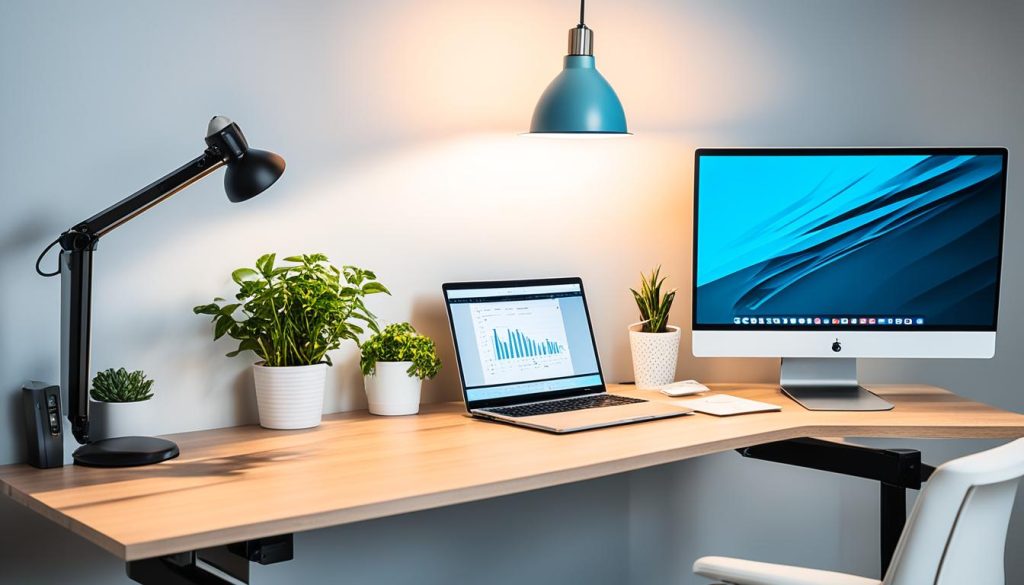
Task Lighting Recommendations
Task lamps are vital for focused work. They boost reading accuracy by 15% and cut eye strain by 30%. For general office work, aim for 300-500 lux of light. For detailed tasks, go up to 500-1000 lux. LED bulbs save energy and last longer than old incandescent bulbs.
Avoiding Glare and Eye Strain
Reducing glare is crucial for eye health. Place lights so they don’t reflect off your screen. Think about using anti-glare filters on your monitor. Follow the 20-20-20 rule: every 20 minutes, look at something 20 feet away for 20 seconds. This can cut eye strain complaints by 50%.
- Adjust screen brightness to match your surroundings
- Use task-based lighting zones for different activities
- Choose lighting with a color temperature of 5000-6500 Kelvin
- Keep your monitor about 20-24 inches from your eyes
By using these ergonomic lighting tips, you can make your home office comfy and productive. It will also help keep your eyes healthy and improve your work.
Ergonomic Accessories for Enhanced Comfort
Your home office setup isn’t complete without the right ergonomic accessories. These small additions can make a big difference in your comfort and productivity. Let’s explore some must-have items for your workspace.

Wrist rests are key for supporting your hands during long typing sessions. They keep your wrists in a neutral position, reducing strain and discomfort. Choose soft, cushioned options that fit your keyboard and mouse pad.
Document holders are also crucial. They keep papers at eye level, cutting down on neck strain from looking down at your desk. Place them next to your monitor for easy access while you work.
- Footrests: Support your feet and improve circulation
- Monitor arms: Adjust screen height and distance for optimal viewing
- Desk lamps: Provide task lighting to reduce eye strain
- Cable management solutions: Keep your workspace tidy and safe
An ergonomic cushion can also make a big difference. It turns an ordinary chair into a more supportive one. It helps align your spine and reduces pressure on your lower back.
“A well-organized desk with proper ergonomic accessories can boost productivity by up to 20%,” says ergonomics expert Jane Smith.
Investing in these ergonomic accessories can greatly improve your work-from-home experience. They help maintain proper posture, reduce physical strain, and create a more efficient workspace. Remember, small changes can lead to big improvements in your daily comfort and productivity.
Creating an Ergonomic Workspace Layout
A well-designed ergonomic workspace layout can boost your comfort and productivity. Let’s explore how to arrange your office for optimal performance and health.
Optimal furniture arrangement
Start by placing your desk and chair so you can move easily. Keep items you use often within reach to avoid strain. Your monitor should be 20-40 inches away, with the top line at or below eye level.
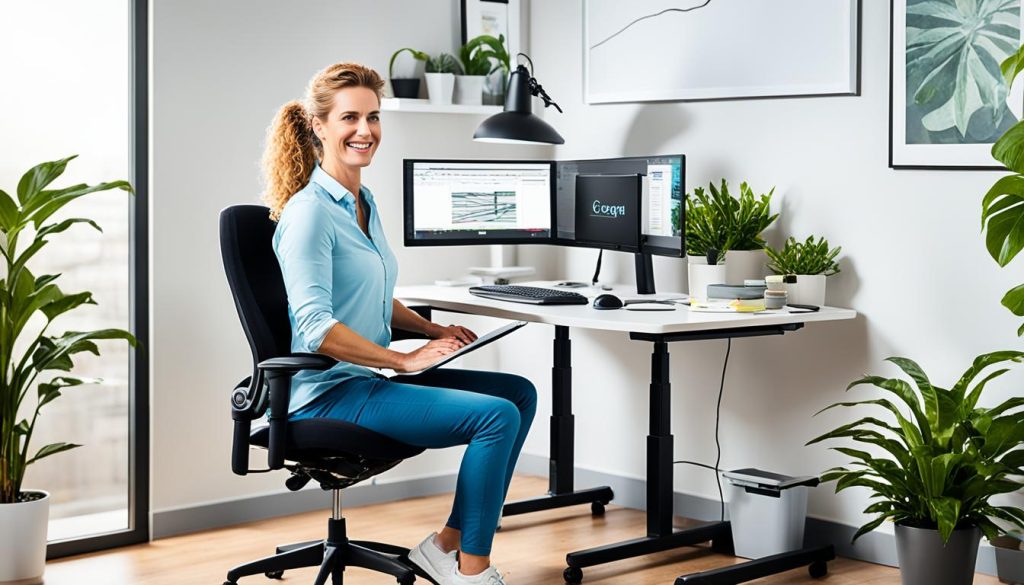
Incorporating movement in your workspace
Movement is key to a healthy work environment. Consider using a standing desk or an under-desk treadmill to switch between sitting and standing. Every 20 minutes, take a 20-second break to look at something 20 feet away.
This simple practice can reduce eye strain and improve your overall well-being.
Storage solutions for a clutter-free environment
Effective office organization is key for a productive workspace. Use vertical storage to save space and keep your desk clear. Implement cable management systems to reduce distractions and create a cleaner area.
A tidy environment can reduce stress and improve focus, making your work better.
“Creating an ergonomic office is like a puzzle where all components need to work together for optimal results,” says Alan Hedge, professor emeritus at Cornell University.
By using these ergonomic tips, you can make your home office support your health and increase your productivity.
Maintaining Proper Posture While Working from Home

Working from home is now common, but keeping good posture is key. It helps avoid discomfort and health problems. Whether sitting or using a standing desk, the right posture is crucial for staying productive and healthy.
For ergonomic sitting, make sure your feet are flat on the floor and knees are at a 90-degree angle. Support your lower back and adjust your chair so your arms rest on the desk. This setup reduces strain on your spine and muscles.
For standing desks, stand with your weight evenly on both feet, shoulders relaxed, and knees slightly bent. This stance prevents fatigue and boosts circulation.
Don’t forget to stretch and move regularly. Set reminders to check your posture all day. Simple stretches like shoulder rolls and neck stretches can ease tension and improve posture.
- Keep your monitor at eye level to avoid neck strain
- Position your keyboard and mouse within easy reach
- Use a footrest if your feet don’t comfortably reach the floor
By focusing on proper posture and creating an ergonomic workspace, you’ll lower the risk of musculoskeletal issues. This will also boost your productivity while working from home.
Adjusting Your Ergonomic Setup for Different Tasks
Task-specific ergonomics are key to staying comfortable and productive at work. Your home office should change with your tasks, from computer work to reading and video calls.
Computer Work vs. Reading/Writing Tasks
Place your monitor at arm’s length with the top of the screen at eye level for computer use. For reading or writing, use a document holder to ease neck strain. Make sure your desk is at the right height for typing, with elbows at 90 degrees.
Mastering Sit-Stand Transitions
Changing positions often helps avoid sitting too long. Try to switch every 30 to 60 minutes. Start with short standing periods and increase them over time. Pay attention to your body and adjust as needed.
- Take 1-2 minute stretch breaks every 20-30 minutes
- Vary your work posture throughout the day
- Use a footrest for added comfort when sitting
Ergonomic Considerations for Video Conferencing
For video calls, place your camera at eye level to keep a good posture. Make sure the lighting is right to cut down on eye strain. Follow the 20-20-20 rule: look 20 feet away for 20 seconds every 20 minutes to rest your eyes.

An ergonomic workspace is not set in stone. Check and tweak your setup often to fit your tasks and comfort. By using these tips, you’ll make your home office more comfy and productive.
Budget-Friendly Ergonomic Solutions
Creating an affordable ergonomic workspace doesn’t have to be expensive. With creativity, you can change your home office without spending a lot. Let’s look at some DIY solutions and low-cost improvements that help with comfort and productivity.
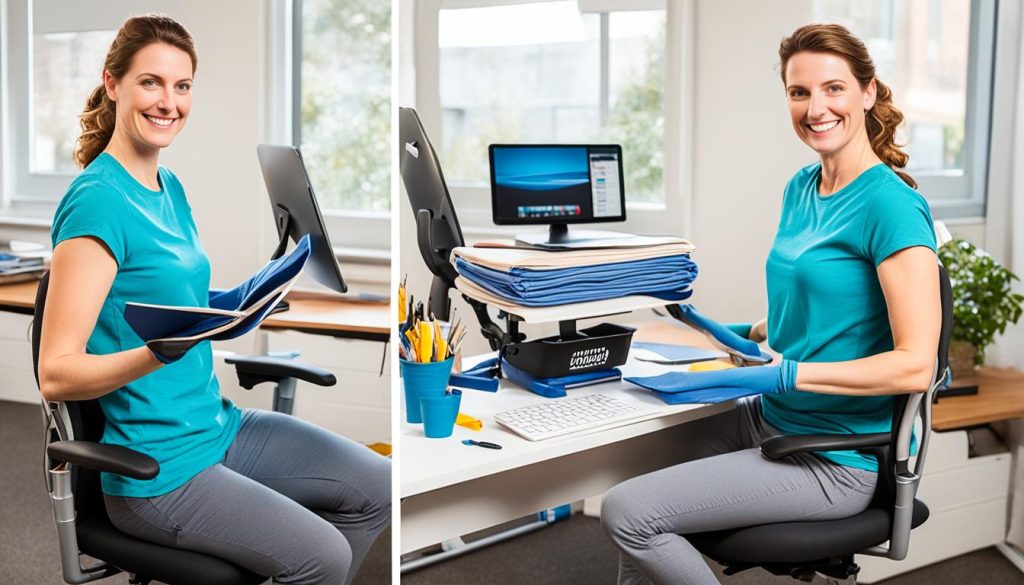
Begin by lifting your monitor to eye level with books or boxes. This easy step helps prevent neck pain and keeps your posture right. For back support, use a rolled towel behind your lower back. If you want a standing desk, try using a strong box on your current desk.
Buy ergonomic items step by step. An ergonomic chair is a big investment, but start with a budget-friendly one and upgrade later. The same is true for keyboards and mice. Remember, how you position these items is key for comfort.
- Use the 20-20-20 rule: Every 20 minutes, look at something 20 feet away for 20 seconds
- Create a DIY footrest with a small box or stack of books
- Improve lighting with affordable desk lamps to reduce eye strain
Don’t forget about moving! Add mini-exercises to your day. Stand up, stretch, or walk a bit. These simple activities greatly improve your ergonomic setup without costing anything.
“The best ergonomic solution is the next position.”
By using these budget-friendly tips, you’ll make a comfortable and productive workspace. Remember, small changes can greatly improve your work-from-home setup.
Customizing Your Ergonomic Setup for Personal Needs
Your home office should reflect your unique style. Making it ergonomic is key for comfort and productivity. With more US workers at home, it’s vital to adjust your setup for your needs.
First, think about your body type and health concerns. Make sure your chair height lets your thighs sit parallel to the ground. This helps prevent muscle pain and discomfort.
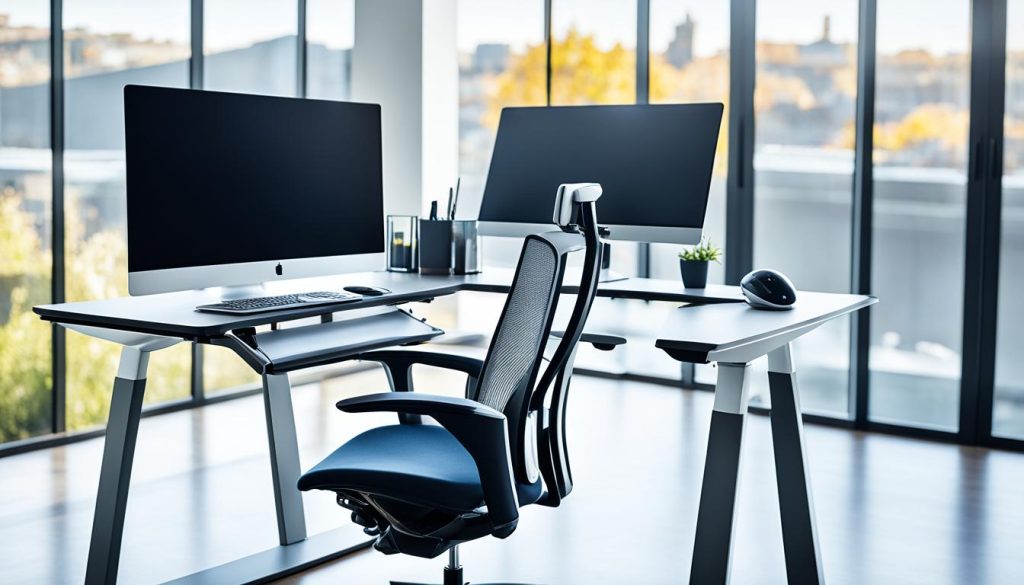
Adaptive office equipment changes the game. Think about getting an ergonomic chair with adjustable lumbar support. These chairs fit different body types and help you sit right. For those who like standing, a sit-stand desk is great for health and flexibility.
Lighting is also important. Natural light can make you 10% more productive and less sleepy. Place your desk near a window if you can. Mirrors can also help reflect light into your workspace.
- Choose blue paint for enhanced focus
- Opt for green to create a calming effect
- Keep your space clutter-free for up to 20% productivity increase
Ergonomic adjustments don’t have to be expensive. A $30 chair pad can greatly improve your comfort. Try different setups and pay attention to what your body tells you. What works for others might not work for you, so customize your space until it feels perfect.
Final Thoughts
Creating an ergonomic workspace at home is a smart move for your health and work efficiency. About 80% of remote workers suffer from back pain due to bad posture and the wrong furniture. Companies like Autonomous offer affordable packages with two-year warranties for both individuals and businesses.
Ergonomic workspaces do more than just make you comfortable. Standing desks can help you stay focused by clearing your mind. Proper storage keeps your office tidy. And a LED desk lamp can stop eye strain in dim rooms.
Don’t forget, a sound system can boost your motivation and focus if you like listening to music while you work.
Improving your workspace is an ongoing task. Always check and tweak your setup to keep it perfect for your comfort and work. By focusing on good posture, placing your equipment right, and moving around, you’re not just setting up a workspace. You’re investing in your health and career.
With the right ergonomic furniture and accessories, you’re ready to handle your work tasks efficiently and comfortably.


